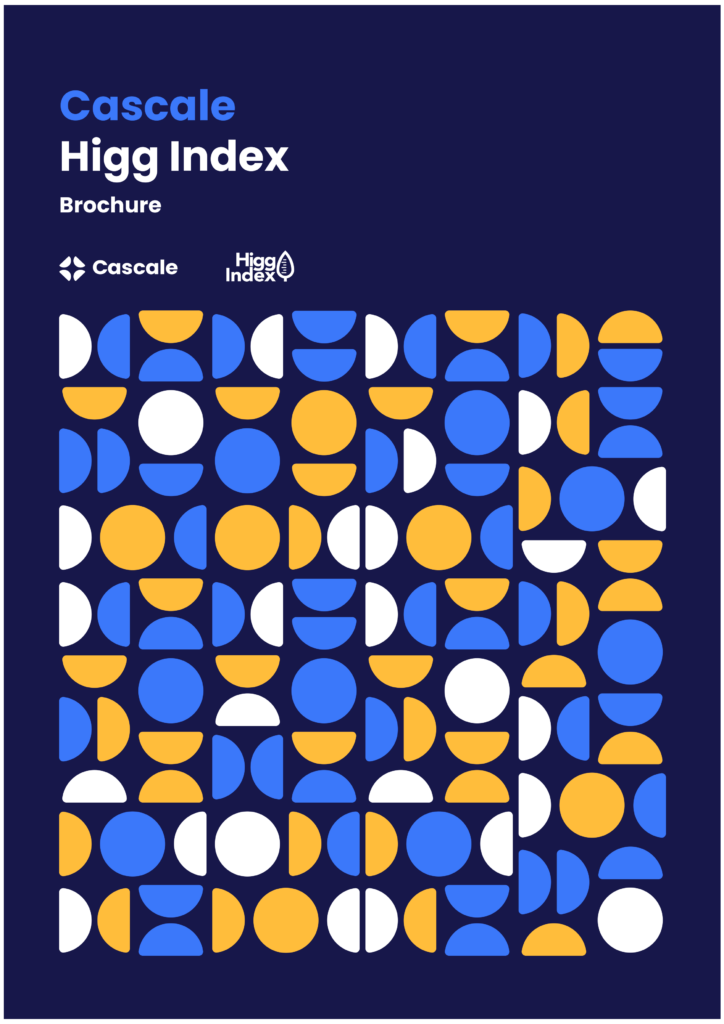
Dear Fashion: Let’s Step Up and Get Aligned
In a recent opinion editorial with WWD, CEO Colin Browne argues fashion needs to take more serious and coordinated action on sustainability. Read the highlights here!
This webinar was an introduction into the Higg BRM and a live Q&A session to answer any related questions.

Amsterdam, Hong Kong, Oakland (CA) – March 4, 2024: Cascale (formerly the Sustainable Apparel Coalition) has launched the latest version of the Higg Brand and Retail Module (BRM), part of the Higg Index suite of tools. This update reflects Cascale’s commitment to continuously evolving, updating, and refining the Higg Index to meet the needs of members, users, and the industry.
The Higg BRM is the leading framework specific to the textile, apparel, and footwear industry designed for brands and retailers to evaluate, assess, and improve Environmental, Social, and Governance (ESG) performance. The tool assesses 11 critical impact areas along global value chains to foster a holistic approach to sustainability.
The Higg BRM 2023 update, launched in collaboration with Worldly – the exclusive platform for the Higg Index tools, which has become the leader in environmental and social impact data for the apparel and footwear industry – will be live on Worldly’s platform today. While the Higg BRM 2023 update is minor, it brings a multitude of benefits to users, including more refined guidance, new social metrics, and a framework designed to keep pace with rapidly evolving sustainability landscapes. The Higg BRM remains consistent and comparable with previous versions, allowing for year-over-year tracking and continuous improvement, and aims to help organizations respond to the unique challenges that users face to facilitate significant, sustainable change for the industry.
“The Higg BRM stands as a beacon for sustainability in the fashion industry, guiding brands and retailers through their sustainability journeys,” said Maravillas Rodriguez Zarco, senior director, Higg Index Strategy & Operations at Cascale. “The Higg BRM is more than a tool—it’s a community’s commitment to a sustainable future. As we stride forward and converge with key frameworks, including the Textile Exchange’s Material Benchmark and the ZDHC Brands to Zero program, our members are empowered to craft sustainability strategies that are not only consistent but impactful.”
Higg BRM 2023 Benefits
Through the Higg BRM, brands and retailers are able to build consistent corporate sustainability strategies to deliver more effectively on ESG goals and industry needs, while avoiding duplication across sustainability initiatives. Furthermore, the Higg BRM can assist with supporting members and users in their reporting obligations. Cascale is actively evolving the tool to address potential gaps between the Higg BRM and the CSRD.
A new feature of the Higg BRM is upgraded benchmarking capabilities that provide a holistic view of a company’s performance, spotlight emerging trends, and uncover opportunities for continuous improvement. Since the last major update, the Higg BRM now assesses the entire value chain to provide a more comprehensive view of a company’s sustainability journey.
Additionally, Higg BRM verification is now accessible to all users (but remains optional for Cascale members), providing more accurate and trusted data, fostering deeper insights into performance metrics and data, and providing new avenues for continuous improvement.
The Journey to Update the Higg BRM
In 2022, Cascale initiated a discovery phase to identify the industry’s needs and the areas where the Higg BRM could improve. The organization interviewed 78 members and evaluated 15 assessment frameworks. Finally, in close collaboration with members and industry partners, Cascale began to build the new Higg BRM tool. Key industry collaborators included the Apparel Alliance members Textile Exchange and ZDHC, as well as Fair Wear and STTI. These organizations have contributed to the development of specific content on chemicals, materials, biodiversity, circularity, and responsible purchasing practices. In 2023, a more streamlined version of the Higg BRM was introduced that included an exclusive, industry-specific ESG framework.
In 2023, a verification pilot was conducted with 11 Cascale member brands and three verifier bodies. Upon completion of the pilot, Cascale identified opportunities for improvements and tool enhancement to improve data accuracy and meet industry needs, further cementing the commitment to continuous improvement and evolution of the Higg Index tools.
To help members better understand the latest update and changes, Cascale will host a members-only Higg BRM Launch Webinar on Thursday March 7, to present key information and resources, and share what’s next for the Higg BRM.
About the Higg BRM
The Higg BRM is the leading framework specific to the textile, apparel, and footwear industry designed for brands and retailers to evaluate, assess, and improve Environmental, Social and Governance (ESG) performance. The tool assesses 11 critical impact areas along global value chains to foster a holistic approach to sustainability.
About Cascale
Cascale is the global nonprofit alliance empowering collaboration to drive equitable and restorative business practices in the consumer goods industry. Spanning over 300 retailers, brands, manufacturers, governments, academics, and NGO/nonprofit affiliates around the globe, we are united by a singular vision: To catalyze impact at scale and give back more than we take to the planet and its people. Formerly known as the Sustainable Apparel Coalition, Cascale owns and develops the Higg Index and a unified strategy for industry transformation.
LinkedIn | X | Instagram | Facebook | YouTube
About Worldly
Worldly is the planet’s most comprehensive impact intelligence platform, trusted by 40,000+ major brands, retailers, and manufacturers in fashion, outdoor, home goods, toys, and more. Worldly uniquely collects high-resolution primary data specific to companies’ value chains, operations, and products, providing insight into true impacts across carbon, water, chemistry, and labor. Featuring the most comprehensive source of ESG data for global manufacturers and the largest library of materials and product impacts, Worldly empowers businesses to scale responsibility into their global operations, faster and more accurately. Hosting, connecting with, and supporting the leading industry solutions and methodologies including ZDHC, Bluesign, and the Higg Index – the most widely-adopted measure of sustainability in the apparel industry – Worldly delivers the insights businesses need to reduce their impact, comply with emerging regulatory and financial disclosure requirements, and meet the expectations of a new generation of customers. www.worldly.io


So many of us appreciate how much the natural world means to our mental and physical health. But as nature nears a tipping point, there’s now so much more at stake.
Nature loss now threatens people and the planet. To put this in perspective, our world’s wildlife populations plummeted by 69% between 1970 and 2022 due to our unsustainable use of our planet’s resources.
That’s not just a tragedy for all the incredible life-forms that run, fly, swim, grow and inhabit the world alongside us, enriching us in countless ways. It’s an alarming sign of how quickly we’re moving towards the collapse of complex, interwoven ecosystems on which all of life on earth depends – including us.
We need fertile soils, thriving oceans, plentiful forests, balanced and diverse species and clean water systems to survive. Scientists and experts warn that we need every one of these aspects of nature to help us reduce the intensity and frequency of climate-related risks.
30 x 30 is a wake-up call to use the tools and knowledge we have and unleash the creativity and innovation needed to restore nature before it’s too late.
The 30 x 30 goal is to put aside 30% of the world for nature by 2030. It was agreed at the United Nations Biodiversity Conference (COP15), and is an ambitious but vital target.
30 x 30 gives us aligned goals that we collectively need to hold ourselves accountable to, and to achieve, in order to bring nature back from the brink.
So what does that mean for our industry?
The textile and apparel industry has huge impacts on nature, due to our use of water and chemicals, and our greenhouse gas emissions. These are all key drivers of biodiversity loss.
But the way I see it, this heavy impact also offers us great opportunities in terms of reversing the trend, co-creating solutions together and positively contributing to the global communities in which we operate.
Here’s one example that proves we not only urgently need to do this, but that we absolutely can.
At the Sustainable Apparel Coalition (SAC), we continue to see companies putting competition aside to collaborate to achieve a 45% reduction in emissions by 2030.
Our Decarbonization Program is the result of work we are doing with our members and industry partners, as are many other industries, to ensure meaningful action and impact. It will take nothing less than working hand in hand across the value chain to increase education, sharing of best practices and ensuring real progress towards shared goals. While there is more to do, we’ve learned a lot from it. So let’s build on these learnings to advance progress more rapidly when it comes to nature restoration.
What’s the first thing we know we need to do? Get our framework right.
We need to use science-based targets for nature to form action plans that everyone in our sector is working towards. By aligning on achieving science-based, measurable targets and benchmarks, SAC members can make real and vital progress.
Our industry has an ability to bring people and knowledge together to collaborate and co-create solutions; catalyzing collective action to protect people and planet.
The era of working in silos is over. The future lies in harnessing the textile and apparel industry’s vast amount of talent, creativity, innovation and ingenuity, and collaborating to protect nature.
Let’s also make the most of the tools and systems we’ve created to take action against reversing biodiversity loss.
At SAC we’re already incorporating biodiversity within our Higg Index suite of tools that allow brands and retailers to assess their impacts.
For example, we recently made biodiversity a category in a major update to our Higg Brand and Retail Module (BRM), one of the five assessment tools within the Higg Index, allowing brands and retailers to assess their impacts when it comes to land use and habitat protection, including more in-depth questions on water and circularity as key levers of change.
We developed the update in collaboration with members and key partner organizations to ensure close alignment with standard assessment protocols.
We’re also exploring opportunities to utilize our Higg Facility Environmental Model (FEM) to help achieve nature-based targets – including using the vast amount of data we have gathered on chemical usage, water usage and wastewater, to identify hotspots where businesses can drive collective action for substantial impact.
Our data, insights and scale of our membership offer significant opportunities for helping to address fashion’s biodiversity cost.
Reversing the alarming rate of nature loss, and creating a thriving, resilient and just future, requires urgently transforming our systems. Based on more than a decade of collaboration, we know that if you put in place the tools, processes and policies, they do work. There are countless examples of specific actions that can yield outsized positive impacts, but more needs to be done to significantly scale these types of interventions to halt and reverse biodiversity loss.
From boardrooms and sourcing teams to manufacturing floors and policy makers, now’s the time for radical collaboration to restore nature. Together, we can make the changes needed to bring nature back from the edge.

San Francisco, Amsterdam, Hong Kong – March 01, 2023: The Sustainable Apparel Coalition (SAC), in collaboration with technology partner Higg, has today released the latest version of the Higg Brand & Retail Module (BRM), one of the five assessment tools in the Higg Index. The Higg BRM is a leading, holistic framework that creates an industry specific method for brands and retailers to evaluate, report on and improve Environmental, Social and Governance (ESG) performance along their global value chains. The SAC has invested in a major update of the tool which will feature a new assessment structure and updated methodology, underpinned by a due diligence approach. The update will encourage brands and retailers to focus on real action, impact and results.
Recent findings from The Industry We Want, in partnership with Fair Wear, the Ethical Trading Initiative (ETI) and the Sustainable Apparel Coalition (SAC), has revealed the apparel and footwear industry is not making fast enough progress on purchasing practices, supply chain wages and greenhouse gas (GHG) emissions. In order to drive the scale of transformation needed, brands and retailers need a clear and standardized picture of their environmental and social hotspots, to create a clear roadmap for transformation.
This new version of the assessment has been reorganized across 11 key areas, split across three pillars (environmental impacts, social impacts, governance) to be more relevant to where the industry needs to drive change, faster. The assessment has added biodiversity as a new impact area and now features more in depth questions on water and circularity as key impact areas and levers of change in the tool. The questions have also been revised to align with best in class standards; for example alignment with best practice guidance on responsible purchasing practices. Additionally, the scoring methodology has been simplified so it can be shared with users openly. The Higg BRM now provides one finite score out of 100, in addition to score breakdowns per pillar and impact area, making it easier to understand, communicate and benchmark against peers.
The assessment has been restructured to provide greater value for different organizations to prioritize our industry’s pressing ESG issues and focusing on impacts and results. Other benefits include the reduction of reporting burden through alignment with relevant frameworks and by eliminating the duplication across the entire questionnaire.
The update is based on research by the SAC’s Higg BRM team and is the result of one year of consultations and with over 75 stakeholders including members and industry experts to ensure close alignment with standard assessment protocols. It has been developed in collaboration with members, key partner organizations including Apparel Alliance members Textile Exchange and ZDHC who contributed to the development of specific content on materials, biodiversity, circularity and chemicals. The SAC also engaged STTI and the Multi-Stakeholder Initiatives Working Group of the Common Framework of Responsible Purchasing Practice (CFRPP), represented by Fair Wear, who provided input and feedback on the responsible purchasing practices section of the assessment. SAC members across all territories were also consulted and the SAC hosted three regional roundtables to ensure all geographies were represented.
Jeremy Lardeau, Vice President, Higg Index at the Sustainable Apparel Coalition, said: “We are excited to release the latest version of our Higg Brand & Retail Module, which marks a major milestone for the SAC. This update is the result of an incredible level of engagement with experts and stakeholders from across the industry, to whom we are truly grateful for the time and input provided. This process has allowed us to better align with existing industry assessment frameworks, and make sure we are addressing the needs and expectations of our members and the industry at large. Our tools must evolve to continuously improve, and while this update is a step in that direction, we will continue to iterate the BRM as the industry progresses, legislation evolves and we continue to gather insights and feedback from BRM users and other stakeholders.”
Maravillas Rodriguez Zarco, Director, Higg Brand & Retail, at the Sustainable Apparel Coalition, said: “The release of the latest version of our Higg Brand & Retail Module is a clear reflection of our mission at the SAC to transform business for exponential impact through groundbreaking tools, collaborative partnerships, and trusted leadership for industry sustainability. From the new assessment structure, to the updated methodology, we are proud of the work we have done to get to this point, we believe the latest version will provide deeper insights and value for brands and retailers and we look forward to continuing supporting them on their sustainability journeys.”
Magnus Dorsch, Head of Corporate Sustainability, About You said:
“The launch of the updated Higg BRM marks a major milestone for the SAC, its members, and the industry at large. We are honored to have contributed to the work that went into the development of the new version. Since joining the SAC in January 2021 and adopting the Higg BRM, we have supported our brand partners in aligning on a unified approach towards sustainable practices, helping them understand where they stand regarding their sustainability journeys and how to continue to support them to improve and drive progress. We believe the updated Higg BRM will serve to help us continue calibrating our ESG strategy to ensure consistency in our progress and reporting and look forward to seeing how it continues to evolve to meet the needs of the industry.”
Sarah Needham, Director of Stakeholder Engagement, Textile Exchange said:
“It is exciting to see the Sustainable Apparel Coalition’s investment to move the Higg Brand & Retail Module in this direction, adding crucial updates including biodiversity as a new impact area and moving to closer alignment with our Materials Benchmark program (formally known as Corporate Fiber and Material Benchmark). We are pleased that as a part of the apparel alliance, we can continue to support on progressing our shared goal of moving the industry towards 45% GHG reduction by 2030 by providing a source for raw materials uptake information, and collaborate to streamline reporting across the fashion, apparel and textile industry.”
Klaas Nuttbohm, ZDHC Implementation Director said:
“We are excited for the opportunity to collaborate with the SAC and create greater alignment between the two organizations. The integration of the ZDHC Brands to Zero Assessment (BtZ) into the Higg BRM means a big step forward for both our organizations. This is a major advance for the apparel alliance partners to align the programmes and tools which will lead to the opportunity for our Contributor Brands to benefit from utilizing the BtZ results in the BRM reporting.”
Margreet Vrieling Fair Wear, chair of the Multi-Stakeholder Initiatives Working Group on the CFRPP, said: “We welcome the efforts of the Sustainable Apparel Coalition to seek closer alignment to the Common Framework for Responsible Purchasing Practices, developed by the MSI working group, within its Higg Brand & Retail Module. Identifying and assessing the risks and negative impacts of purchasing practices in the buyer-supplier relationship is key to mitigate negative effects on suppliers and workers. By using the responsible purchasing practices as they have been laid down in the Common Framework as input for the BRM responsible purchasing practices questions, the SAC reinforces the importance of collaboration and convergence to drive progress within our industry.”
Karin Ekberg GmbH, Founder & CEO Leadership & Sustainability said:
“The launch of the new BRM module is a great step forward for SAC and its members. It has been a pleasure for us at Leadership & Sustainability to be part of the process to develop the new BRM. As it is now aligned with international ESG standards and expectations, we believe this version will meet market demands, will support brands and retailers to measure and improve their ESG performance as well as communicate their efforts in a transparent and trustworthy manner. Congratulations to the SAC team and all contributing members!”
Brands and retailers can use the Higg BRM to understand their performance in these areas: Environment: climate, water, waste, biodiversity and chemicals; Social: workers, employees, consumers and communities; Governance: structure and management, ethics and behavior.
The updated Higg BRM is now available for brands and retailers to measure and report on their ESG impacts to understand their progress and identify areas for improvement with clarity and transparency. If your organization is interested in using the Higg BRM, please find more information here.
– ENDS –
About the Sustainable Apparel Coalition:
The Sustainable Apparel Coalition (SAC) is an independent and impact-creating organization that aims to lead the industry toward a shared vision of sustainability based upon a joint approach for measuring, evaluating, and improving performance.
As a non-profit organization, it has members from across the apparel, footwear and textile sector, but exists independently outside any one company so that it can drive progress. The SAC’s collective action efforts bring more than 280 global brands, retailers, manufacturers, NGOs, academics and industry associations together. They represent about half of the apparel and footwear industry along the whole supply chain – from sustainability pioneers to organizations just getting started.
Before the SAC existed, companies worked in a siloed way, using their own programs and measurements that lacked standardization and an ability to drive collective action. In 2009, Walmart and Patagonia identified this as a serious problem. Joining forces, they brought together peers and competitors from across the sector, to develop a universal approach to measuring sustainability performance and founded the Sustainable Apparel Coalition.
Learn more about the business value and benefits of the Higg Index.
